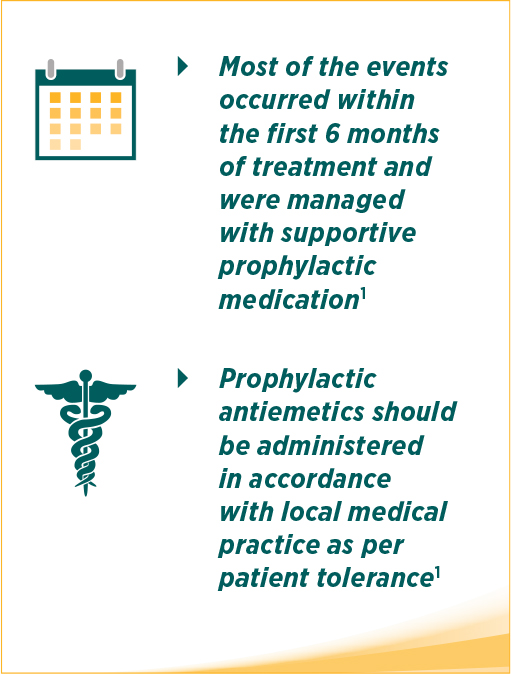RYDAPT: Most adverse events in the clinical trials were grade 1/2
Adverse drug reactions reported in ≥10% of patients in the advanced SM studies1
| Adverse Drug Reactions | RYDAPT 100 mg twice daily (N=142) |
|
| All grades % | Grades 3/4 % | |
| Infections and infestations | ||
| Urinary tract infection | 13 | 2.8 |
| Upper respiratory tract infection | 11 | 1.4 |
| Nervous system disorders | ||
| Headache | 26 | 1.4 |
| Dizziness | 13 | 0 |
| Respiratory, thoracic, and mediastinal disorders | ||
| Dyspnoea | 18 | 5.6 |
| Cough | 16 | 0.7 |
| Pleural effusion | 13 | 4.2 |
| Epistaxis | 12 | 2.8 |
| Gastrointestinal disorders | ||
| Nausea | 82 | 5.6 |
| Vomiting | 68 | 5.6 |
| Diarrhoea | 51 | 6.3 |
| Constipation | 29 | 0.7 |
| General disorders and administration-site conditions | ||
| Oedema peripheral | 35 | 3.5 |
| Fatigue | 31 | 8.5 |
| Pyrexia | 27 | 4.2 |
Common adverse drug reactions (ADRs) leading to discontinuation were GI-related events (4.2%)1
Laboratory abnormalities reported in patients in the 2 advanced SM studies1
| Laboratory abnormalities | RYDAPT 100 mg twice daily (N=142) |
|
| All grades % | Grades 3/4 % | |
| Hyperglycaemia (non-fasting)* | 93.7 | 19.0 |
| Absolute lymphocyte decreased* | 73.2 | 45.8 |
| ANC decreased* | 58.5 | 26.8 |
| Total bilirubin increased* | 40.1 | 4.9 |
| Lipase increased* | 39.4 | 17.6 |
| AST increased* | 33.8 | 2.8 |
| ALT increased* | 33.1 | 3.5 |
| Amylase increased* | 20.4 | 7.0 |
| Weight increased* | 5.6 | 2.8 |
*Frequency is based on laboratory values.
Contraindications, warnings and precautions
Contraindications: Patients with hypersensitivity to midostaurin or to any of the excipients. Concomitant administration of potent CYP3A4 inducers1
Warnings and precautions include neutropenia and infections, cardiac dysfunction, pulmonary toxicity, embryo-fetal toxicity and lactation, severe hepatic impairment, severe renal impairment, interactions, and excipients.1 Please see the full safety information and the Basic Succinct Statement to learn more
GI-related events were the most common ADRs not related to laboratory abnormalities in the 2 advanced SM studies and were managed with antiemetics1

Grade 3/4 ADRs included diarrhoea (6.3%), nausea (5.6%), vomiting (5.6%), GI haemorrhage (3.5%), and constipation (0.7%)1
For grade 3/4 nausea and/or vomiting despite optimal antiemetic therapy, interrupt RYDAPT for 3 days (6 doses), then resume RYDAPT at 50 mg twice daily and, if tolerated, gradually increase to 100 mg twice daily1
If vomiting occurs, the patient should not take an additional dose of RYDAPT, but should take the next scheduled dose1
ANC, absolute neutrophil count; ALT, alanine aminotransferase; AST, aspartate aminotransferase; GI, gastrointestinal; SM, systemic mastocytosis.
Reference: 1. RYDAPT [Summary of Product Characteristics]. Novartis Pharma AG; 2017.


